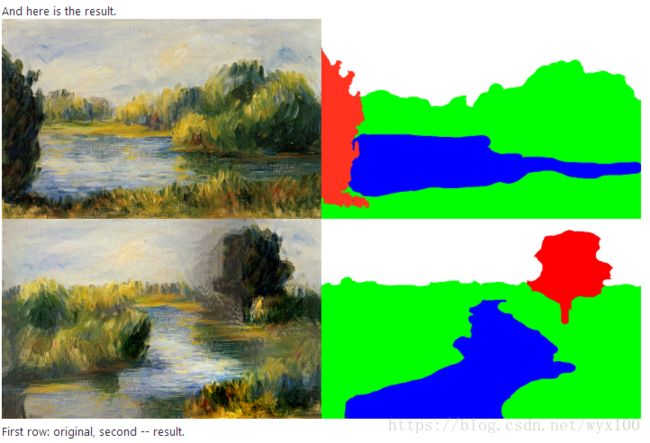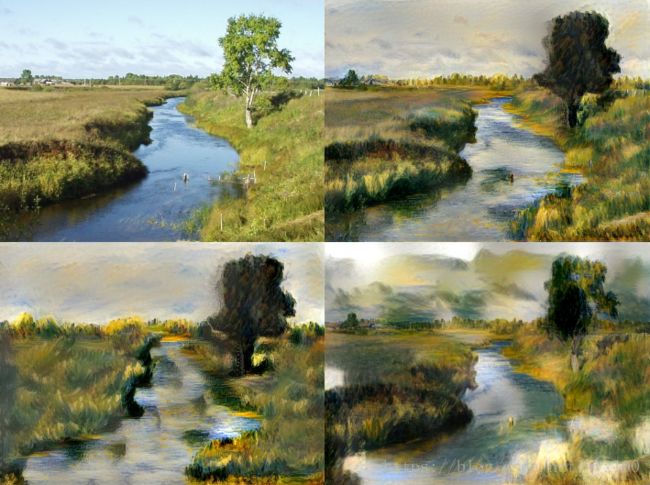官网实例详解4.35(neural_doodle.py)-keras学习笔记四
神经涂鸦
效果展示
https://github.com/DmitryUlyanov/fast-neural-doodle
Upper left: target image. Upper right: neural doodle with target image, i.e. both the masks and content loss were used. Lower left: regular neural doodle without content loss. Lower right: stylization without masks, with high style weight, obtained via neural style code. With high style weight, stylization tends to mix unrelated parts of image, such as patches of grass floating in the sky on last picture. Neural doodle with content loss allows to generate highly stylized images without this problem.
完整项目和素材下载
Keras实例目录
代码注释
'''Neural doodle with Keras
基于Keras的神经涂鸦(随手画画)
# Script Usage
# 脚本使用
## Arguments
参数
```
--nlabels: # of regions (colors) in mask images # 掩模图像中的区域(颜色)
--style-image: image to learn style from # 图像学习风格
--style-mask: semantic labels for style image # 风格图像的语义标注
--target-mask: semantic labels for target image (your doodle) # 目标图像的语义标签(涂鸦)
--content-image: optional image to learn content from # 可选的图像学习内容
--target-image-prefix: path prefix for generated target images # 生成目标图像的路径前缀
```
## Example 1: doodle using a style image, style mask
and target mask.
示例1:使用样式图像、样式掩码和目标掩码进行涂鸦。
```
python neural_doodle.py --nlabels 4 --style-image Monet/style.png \
--style-mask Monet/style_mask.png --target-mask Monet/target_mask.png \
--target-image-prefix generated/monet
python neural_doodle.py --nlabels 4 --style-image Monet/style.png --style-mask Monet/style_mask.png --target-mask Monet/target_mask.png --target-image-prefix generated/monet
```
## Example 2: doodle using a style image, style mask,
target mask and an optional content image.
示例2:使用样式图像、样式掩码、目标掩码和可选内容图像进行涂鸦。
```
python neural_doodle.py --nlabels 4 --style-image Renoir/style.png \
--style-mask Renoir/style_mask.png --target-mask Renoir/target_mask.png \
--content-image Renoir/creek.jpg \
--target-image-prefix generated/renoir
python neural_doodle.py --nlabels 4 --style-image Renoir/style.png --style-mask Renoir/style_mask.png --target-mask Renoir/target_mask.png --content-image Renoir/creek.jpg --target-image-prefix generated/renoir
```
# References
参考
- [Dmitry Ulyanov's blog on fast-neural-doodle](http://dmitryulyanov.github.io/feed-forward-neural-doodle/)
- [Torch code for fast-neural-doodle](https://github.com/DmitryUlyanov/fast-neural-doodle)
- [Torch code for online-neural-doodle](https://github.com/DmitryUlyanov/online-neural-doodle)
- [Paper Texture Networks: Feed-forward Synthesis of Textures and Stylized Images](http://arxiv.org/abs/1603.03417)
- [Discussion on parameter tuning](https://github.com/keras-team/keras/issues/3705)
# Resources
资源
Example images can be downloaded from
实例图片下载地址:
https://github.com/DmitryUlyanov/fast-neural-doodle/tree/master/data
'''
from __future__ import print_function
import time
import argparse
import numpy as np
from scipy.optimize import fmin_l_bfgs_b
from scipy.misc import imread, imsave
from keras import backend as K
from keras.layers import Input, AveragePooling2D
from keras.models import Model
from keras.preprocessing.image import load_img, img_to_array
from keras.applications import vgg19
# Command line arguments
# 命令行参数
parser = argparse.ArgumentParser(description='Keras neural doodle example')
parser.add_argument('--nlabels', type=int,
help='number of semantic labels'
' (regions in differnet colors)'
' in style_mask/target_mask')
parser.add_argument('--style-image', type=str,
help='path to image to learn style from')
parser.add_argument('--style-mask', type=str,
help='path to semantic mask of style image')
parser.add_argument('--target-mask', type=str,
help='path to semantic mask of target image')
parser.add_argument('--content-image', type=str, default=None,
help='path to optional content image')
parser.add_argument('--target-image-prefix', type=str,
help='path prefix for generated results')
args = parser.parse_args()
style_img_path = args.style_image
style_mask_path = args.style_mask
target_mask_path = args.target_mask
content_img_path = args.content_image
target_img_prefix = args.target_image_prefix
use_content_img = content_img_path is not None
num_labels = args.nlabels
num_colors = 3 # RGB # red、green、blue 三个通道
# determine image sizes based on target_mask
# 基于目标掩码确定图像尺寸
ref_img = imread(target_mask_path)
img_nrows, img_ncols = ref_img.shape[:2]
total_variation_weight = 50.
style_weight = 1.
content_weight = 0.1 if use_content_img else 0
content_feature_layers = ['block5_conv2']
# To get better generation qualities, use more conv layers for style features
# 为了获得更好的生成质量,使用更多的卷积层用于风格特征。
style_feature_layers = ['block1_conv1', 'block2_conv1', 'block3_conv1',
'block4_conv1', 'block5_conv1']
# helper functions for reading/processing images
# 读取/处理图像的辅助功能
def preprocess_image(image_path):
img = load_img(image_path, target_size=(img_nrows, img_ncols))
img = img_to_array(img)
img = np.expand_dims(img, axis=0)
img = vgg19.preprocess_input(img)
return img
def deprocess_image(x):
if K.image_data_format() == 'channels_first':
x = x.reshape((3, img_nrows, img_ncols))
x = x.transpose((1, 2, 0))
else:
x = x.reshape((img_nrows, img_ncols, 3))
# Remove zero-center by mean pixel
x[:, :, 0] += 103.939
x[:, :, 1] += 116.779
x[:, :, 2] += 123.68
# 'BGR'->'RGB'
x = x[:, :, ::-1]
x = np.clip(x, 0, 255).astype('uint8')
return x
def kmeans(xs, k):
assert xs.ndim == 2
try:
from sklearn.cluster import k_means
_, labels, _ = k_means(xs.astype('float64'), k)
except ImportError:
from scipy.cluster.vq import kmeans2
_, labels = kmeans2(xs, k, missing='raise')
return labels
def load_mask_labels():
'''Load both target and style masks.
加载目标和样式掩码。
A mask image (nr x nc) with m labels/colors will be loaded
as a 4D boolean tensor: (1, m, nr, nc) for 'channels_first' or (1, nr, nc, m) for 'channels_last'
加载带有m标签/颜色的掩模图像(nr x nc),
带有m标记/颜色的掩模图像(nr x nc)将被加载为4D布尔tensor:(1, m, nr, nc) 用于“channels_first”或(1, nr, nc, m) ,用于“channels_last”。
'''
target_mask_img = load_img(target_mask_path,
target_size=(img_nrows, img_ncols))
target_mask_img = img_to_array(target_mask_img)
style_mask_img = load_img(style_mask_path,
target_size=(img_nrows, img_ncols))
style_mask_img = img_to_array(style_mask_img)
if K.image_data_format() == 'channels_first':
mask_vecs = np.vstack([style_mask_img.reshape((3, -1)).T,
target_mask_img.reshape((3, -1)).T])
else:
mask_vecs = np.vstack([style_mask_img.reshape((-1, 3)),
target_mask_img.reshape((-1, 3))])
labels = kmeans(mask_vecs, num_labels)
style_mask_label = labels[:img_nrows *
img_ncols].reshape((img_nrows, img_ncols))
target_mask_label = labels[img_nrows *
img_ncols:].reshape((img_nrows, img_ncols))
stack_axis = 0 if K.image_data_format() == 'channels_first' else -1
style_mask = np.stack([style_mask_label == r for r in range(num_labels)],
axis=stack_axis)
target_mask = np.stack([target_mask_label == r for r in range(num_labels)],
axis=stack_axis)
return (np.expand_dims(style_mask, axis=0),
np.expand_dims(target_mask, axis=0))
# Create tensor variables for images
# 建立图像张量变量
if K.image_data_format() == 'channels_first':
shape = (1, num_colors, img_nrows, img_ncols)
else:
shape = (1, img_nrows, img_ncols, num_colors)
style_image = K.variable(preprocess_image(style_img_path))
target_image = K.placeholder(shape=shape)
if use_content_img:
content_image = K.variable(preprocess_image(content_img_path))
else:
content_image = K.zeros(shape=shape)
images = K.concatenate([style_image, target_image, content_image], axis=0)
# Create tensor variables for masks
# 建立掩码张量变量
raw_style_mask, raw_target_mask = load_mask_labels()
style_mask = K.variable(raw_style_mask.astype('float32'))
target_mask = K.variable(raw_target_mask.astype('float32'))
masks = K.concatenate([style_mask, target_mask], axis=0)
# index constants for images and tasks variables
# 图像和任务变量的索引常量
STYLE, TARGET, CONTENT = 0, 1, 2
# Build image model, mask model and use layer outputs as features
# image model as VGG19
# 建立图像模型、掩模模型和使用层输出作为特征图像模型VGG19
image_model = vgg19.VGG19(include_top=False, input_tensor=images)
# mask model as a series of pooling
# 掩模模型作为一系列池化
mask_input = Input(tensor=masks, shape=(None, None, None), name='mask_input')
x = mask_input
for layer in image_model.layers[1:]:
name = 'mask_%s' % layer.name
if 'conv' in layer.name:
x = AveragePooling2D((3, 3), padding='same', strides=(
1, 1), name=name)(x)
elif 'pool' in layer.name:
x = AveragePooling2D((2, 2), name=name)(x)
mask_model = Model(mask_input, x)
# Collect features from image_model and task_model
# 从图像模型和任务模型收集特征
image_features = {}
mask_features = {}
for img_layer, mask_layer in zip(image_model.layers, mask_model.layers):
if 'conv' in img_layer.name:
assert 'mask_' + img_layer.name == mask_layer.name
layer_name = img_layer.name
img_feat, mask_feat = img_layer.output, mask_layer.output
image_features[layer_name] = img_feat
mask_features[layer_name] = mask_feat
# Define loss functions
# 定义损失函数
def gram_matrix(x):
assert K.ndim(x) == 3
features = K.batch_flatten(x)
gram = K.dot(features, K.transpose(features))
return gram
def region_style_loss(style_image, target_image, style_mask, target_mask):
'''Calculate style loss between style_image and target_image,
for one common region specified by their (boolean) masks
计算样式图像和目标图像之间的风格丢失,对于由其(布尔)掩码指定的一个公共区域
'''
assert 3 == K.ndim(style_image) == K.ndim(target_image)
assert 2 == K.ndim(style_mask) == K.ndim(target_mask)
if K.image_data_format() == 'channels_first':
masked_style = style_image * style_mask
masked_target = target_image * target_mask
num_channels = K.shape(style_image)[0]
else:
masked_style = K.permute_dimensions(
style_image, (2, 0, 1)) * style_mask
masked_target = K.permute_dimensions(
target_image, (2, 0, 1)) * target_mask
num_channels = K.shape(style_image)[-1]
num_channels = K.cast(num_channels, dtype='float32')
s = gram_matrix(masked_style) / K.mean(style_mask) / num_channels
c = gram_matrix(masked_target) / K.mean(target_mask) / num_channels
return K.mean(K.square(s - c))
def style_loss(style_image, target_image, style_masks, target_masks):
'''Calculate style loss between style_image and target_image,
in all regions.
'''
assert 3 == K.ndim(style_image) == K.ndim(target_image)
assert 3 == K.ndim(style_masks) == K.ndim(target_masks)
loss = K.variable(0)
for i in range(num_labels):
if K.image_data_format() == 'channels_first':
style_mask = style_masks[i, :, :]
target_mask = target_masks[i, :, :]
else:
style_mask = style_masks[:, :, i]
target_mask = target_masks[:, :, i]
loss += region_style_loss(style_image,
target_image, style_mask, target_mask)
return loss
def content_loss(content_image, target_image):
return K.sum(K.square(target_image - content_image))
def total_variation_loss(x):
assert 4 == K.ndim(x)
if K.image_data_format() == 'channels_first':
a = K.square(x[:, :, :img_nrows - 1, :img_ncols - 1] -
x[:, :, 1:, :img_ncols - 1])
b = K.square(x[:, :, :img_nrows - 1, :img_ncols - 1] -
x[:, :, :img_nrows - 1, 1:])
else:
a = K.square(x[:, :img_nrows - 1, :img_ncols - 1, :] -
x[:, 1:, :img_ncols - 1, :])
b = K.square(x[:, :img_nrows - 1, :img_ncols - 1, :] -
x[:, :img_nrows - 1, 1:, :])
return K.sum(K.pow(a + b, 1.25))
# Overall loss is the weighted sum of content_loss, style_loss and tv_loss
# Each individual loss uses features from image/mask models.
loss = K.variable(0)
for layer in content_feature_layers:
content_feat = image_features[layer][CONTENT, :, :, :]
target_feat = image_features[layer][TARGET, :, :, :]
loss += content_weight * content_loss(content_feat, target_feat)
for layer in style_feature_layers:
style_feat = image_features[layer][STYLE, :, :, :]
target_feat = image_features[layer][TARGET, :, :, :]
style_masks = mask_features[layer][STYLE, :, :, :]
target_masks = mask_features[layer][TARGET, :, :, :]
sl = style_loss(style_feat, target_feat, style_masks, target_masks)
loss += (style_weight / len(style_feature_layers)) * sl
loss += total_variation_weight * total_variation_loss(target_image)
loss_grads = K.gradients(loss, target_image)
# Evaluator class for computing efficiency
# 计算效率的评估类
outputs = [loss]
if isinstance(loss_grads, (list, tuple)):
outputs += loss_grads
else:
outputs.append(loss_grads)
f_outputs = K.function([target_image], outputs)
def eval_loss_and_grads(x):
if K.image_data_format() == 'channels_first':
x = x.reshape((1, 3, img_nrows, img_ncols))
else:
x = x.reshape((1, img_nrows, img_ncols, 3))
outs = f_outputs([x])
loss_value = outs[0]
if len(outs[1:]) == 1:
grad_values = outs[1].flatten().astype('float64')
else:
grad_values = np.array(outs[1:]).flatten().astype('float64')
return loss_value, grad_values
class Evaluator(object):
def __init__(self):
self.loss_value = None
self.grads_values = None
def loss(self, x):
assert self.loss_value is None
loss_value, grad_values = eval_loss_and_grads(x)
self.loss_value = loss_value
self.grad_values = grad_values
return self.loss_value
def grads(self, x):
assert self.loss_value is not None
grad_values = np.copy(self.grad_values)
self.loss_value = None
self.grad_values = None
return grad_values
evaluator = Evaluator()
# Generate images by iterative optimization
# 通过迭代优化生成图像
if K.image_data_format() == 'channels_first':
x = np.random.uniform(0, 255, (1, 3, img_nrows, img_ncols)) - 128.
else:
x = np.random.uniform(0, 255, (1, img_nrows, img_ncols, 3)) - 128.
for i in range(50):
print('Start of iteration', i)
start_time = time.time()
x, min_val, info = fmin_l_bfgs_b(evaluator.loss, x.flatten(),
fprime=evaluator.grads, maxfun=20)
print('Current loss value:', min_val)
# save current generated image
# 保存生成图像
img = deprocess_image(x.copy())
fname = target_img_prefix + '_at_iteration_%d.png' % i
imsave(fname, img)
end_time = time.time()
print('Image saved as', fname)
print('Iteration %d completed in %ds' % (i, end_time - start_time))代码执行
Keras详细介绍
英文:https://keras.io/
中文:http://keras-cn.readthedocs.io/en/latest/
实例下载
https://github.com/keras-team/keras
https://github.com/keras-team/keras/tree/master/examples
完整项目下载
方便没积分童鞋,请加企鹅452205574,共享文件夹。
包括:代码、数据集合(图片)、已生成model、安装库文件等。


